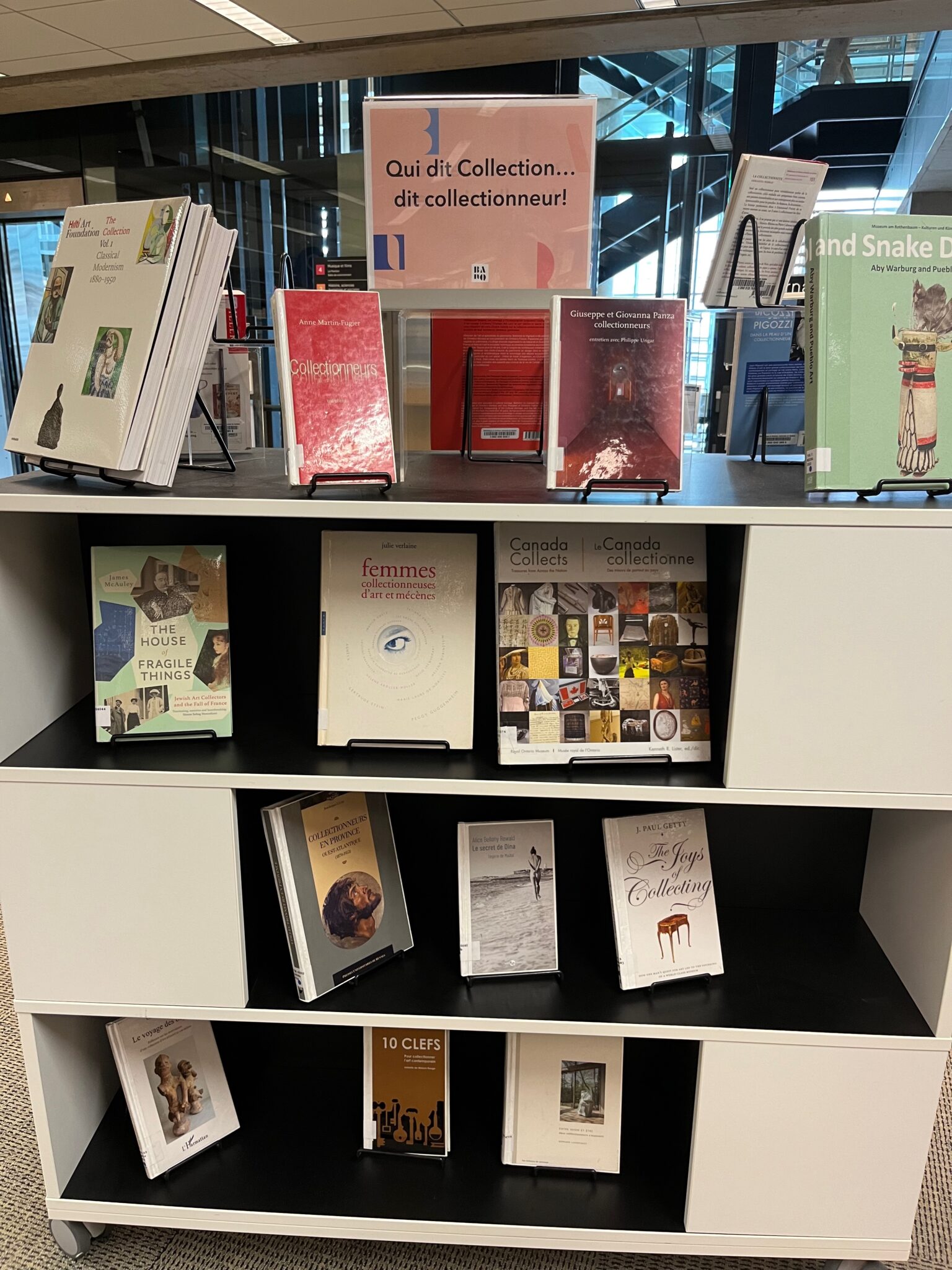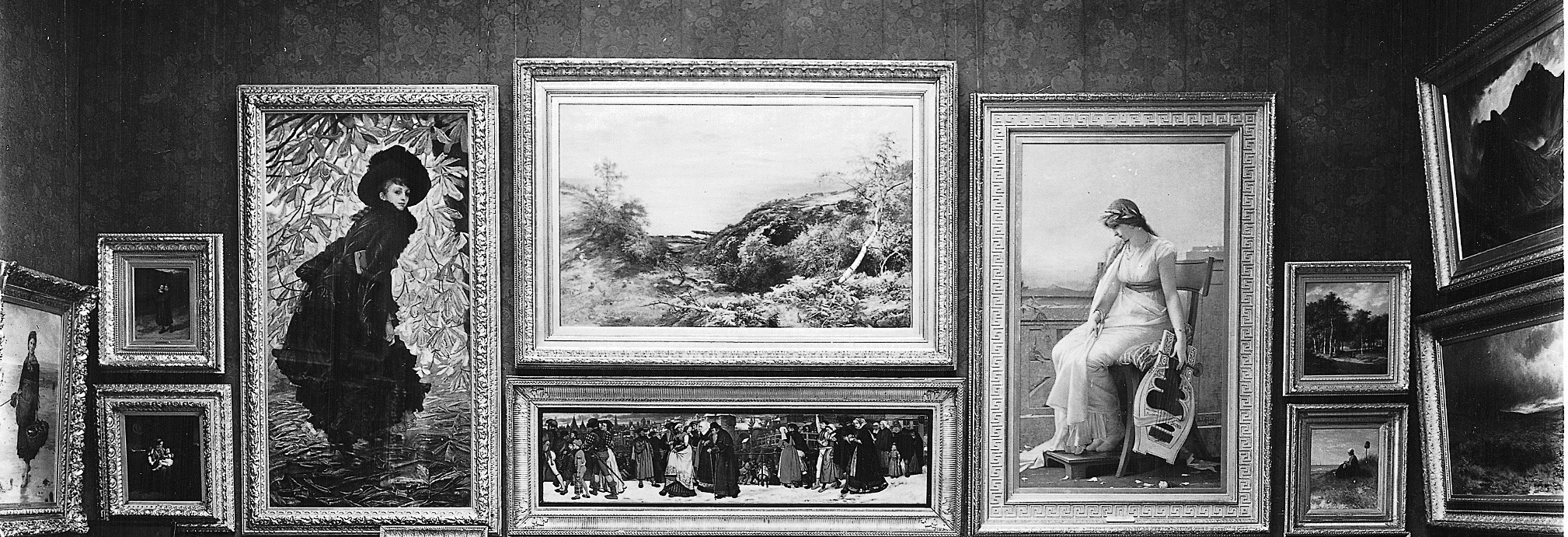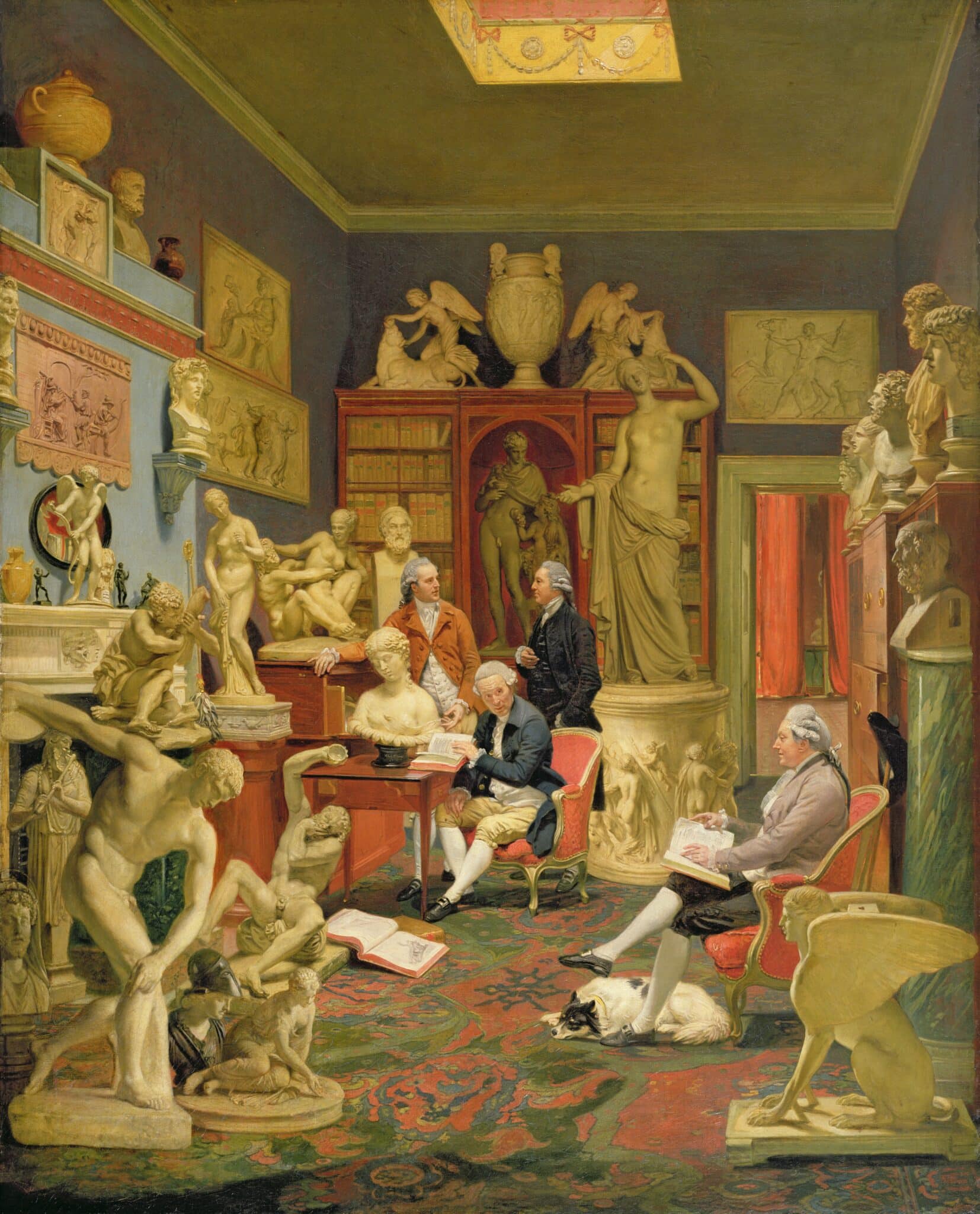
Where there’s a collection… there’s a collector! That’s how, in September, BAnQ’s Grande Bibliothèque celebrated the practice of collecting, underlining its topicality. If you’re a collector, you may have tried to find out more about its origins. If not, this article offers you a brief glimpse into the history of this age-old cultural tradition. At the same time, it attempts to draw up a schematic portrait of the private art collector, according to the historical meaning of this figure who appeared in the 17th century.
Origins and evolution of art collecting
The act of selecting, gathering and preserving precious objects, i.e. building up a collection or a ‘gathering of marvellous objects kept in a sacred place’, seems almost as old as human existence.[i] At least, the earliest traces suggesting such an activity date back to protohistory, particularly in the context of burials, where numerous sophisticated items were discovered with the remains: weapons, vases, statuettes, etc.[ii] Funerary furniture constitutes the first examples of collecting precious objects.[iii] Another evidence of this practice is the gathering of offerings in ancient temples: artifacts, often of great value, were amassed and displayed there. We owe to these places, in particular to the temples of the Muses, and to their collections the name of museum, that space where collections of objects made accessible to the public for its instruction and delectation are assembled today.[iv] Finally, medieval ecclesiastical treasures form a third type of artefact collection, grouping together various works of art, mainly goldsmiths’ and embroiderers’ wares, related to worship.[v]
By their very nature, the collections listed so far are part of a collective framework and have a ceremonial function, testifying to the majesty of the figures they honor. Private collections, assembled in a spirit of pleasure, appeared later. A few ancient forms nevertheless exist. They first appeared in Asian civilizations, with a decisive turning point at the founding of the Chinese empire (late 3rd century BC).[vi] In the Wester world, the first documented private collections concerned ornaments, precious objects and sculptures, most often from spoils of war, gathered by the Romans.[vii] In the Middle Ages, some princes assembled treasures similar in composition and function to their ecclesiastical counterparts.[viii] In France, the Valois dynasty and the Grand Dukes of Burgundy were among the richest collectors of their time in the 14th and 15th centuries.[ix] Above all, it was humanism, with its attraction to a return to original sources and, therefore, to antiquities, that was to be a key vector in the growth of private collections from the end of the 14th century onwards.[x] Renaissance collectors were interested in the remains of Roman antiquity, sought out statues unearthed from excavations to adorn the gardens of their villas and amassed, among other things, antique medals and engraved stones.[xi]
The notion of the art collection, in the modern sense in which Krzysztof Pomian defines it as ‘a group of natural or artificial objects, temporarily or permanently kept out of the circuit of economic activities, subjected to special protection in a closed place arranged for this purpose, and exposed to the eye’, takes shape more specifically from the 17th century onwards.[xii] In addition to antiques, paintings and sculptures by old masters became increasingly sought-after, not only for their artistic but also their commercial value. Formerly determined by the materials used and the time it took to produce them, the price of works was now determined by the artist’s reputation and talent.[xiii] At the turn of the century, an art market emerged in Amsterdam, followed by the gradual establishment of markets in London and Paris.[xiv]

It was in the 18th century that the principle of the private collection and its exhibition space became firmly established. Already underway in the previous century, the turn of the 18th century saw an increase in the volume of works of art traded and a broadening of the interested public.[xv] In Great Britain, the era of the ‘Whig hegemony’, between 1714 and 1744, was characterized by political stability and a flourishing economic situation that benefited a certain social category eager to express its prestige through the mastery of an artistic culture: it was a period when important art collections were being built up.[xvi] It also saw the restoration, even construction, and decoration of residences where collections were displayed, not just in dedicated galleries as in the previous century, but throughout the architectural space.[xvii] This principle was taken up by the first Montreal collectors of British origin, such as Lord Strathcona (1820-1914), a Scottish immigrant who made his career with the Hudson’s Bay Company and on the Canadian political scene, who exhibited his rich art collection in his residence on Dorchester Street, which was enlarged several times.[xviii]
Portrait of the private collector throughout history
Although the figure of the ‘connoisseur’ has existed since the very beginnings of the modern era of collecting, it also took shape during the 18th century.[xix] An inveterate collector, the connoisseur combines two ambivalent facets of the same talent: the faculty of attribution in the broadest sense (associating an object with a civilization, a period, an artistic movement, a hand/artist, etc.) and the judgment of quality, at the origin of a sensitive pleasure. These two skills are the result both of intellectual and material knowledge as well as of a certain intuition and sensitivity. Nevertheless, in the rational current of the Enlightenment, connoisseurship resolutely sought to establish itself as a science, by attempting to provide some rules to follow in order to establish the amateur’s judgment of taste.[xx] Thus, after instituting the artist’s ‘genius’ during the Renaissance, the players in the art world were now considering the spectator’s reception of the work, with a concern for the art lover’s criticism.[xxi]
Over the last decades, art historians have increasingly focused on this key figure in the art world, the collector, in an attempt to establish some of the salient features of his personality and, above all, to understand the driving forces behind his motivation more accurately. Following the strong link he establishes between the art collection and its owner, Krzysztof Pomian posits the idea of the collection as a self-portrait of the collector, ‘[…] composed of objects he has chosen and exhibited, an expression both of his status and wealth, and of his interiority: his knowledge, sensitivity, aspirations, interests and tastes’.[xxii] According to Pierre Cabanne, ‘curiosity, desire, possession, the collector is a man of withdrawal, dissimulation and secrecy’.[xxiii] This author insists on the behavior that distinguishes him from the buyer, who ‘has money […], so he spends. […] He will acquire not works that he discovers, but rather names that reassure him, preferably great names that a wise dealer suggests to him’.[xxiv] The art collector thus appears as a refined and passionate being with a double face: one, masked in order to unearth the coveted objects, the other, unveiled to share his erudition and taste. Already in the heyday of collecting in Montreal, between 1850-1910, these criteria of erudition and taste formed ‘the basis of the image of the ideal collector’.[xxv]

Beyond the appeal to his faculties, the motivations that drive the art lover to collect are varied; over the course of history, three main ones can be highlighted. First and foremost, collectors seek the aesthetic pleasure of contact with works of art. At the same time as private collecting was taking hold in 18th-century Europe, a number of German philosophers were theorizing about the experience of beauty, or in other words, aesthetic emotion.[xxvi] Their current counterpart, Charles Pépin, offers a simplified definition: ‘This strange pleasure, neither simply sensual, nor really intellectual either, this gratuitous, disinterested satisfaction, this evidence that suddenly soothes you when you say: “That’s beautiful”’.[xxvii]The pleasure of appreciating an object of art is matched by the pleasure of finding it. The collector is stimulated by the quest for the rare, unique object that distinguishes his or her good taste: the collector is an opportunity ‘hunter’. As J. Paul Getty (1892-1976) pointed out, ‘One of the greatest joys of collecting lies in the gratification an individual derives from obtaining an object that he wants and that satisfies his own tastes’.[xxviii] Finally, even today, collecting is a form of social recognition. In its private version, this cultural practice first developed within princely circles, where art appreciation was part of the educational imperative; with the growth of wealth among various social classes, it spread to actors – bankers, merchants, literati, etc. – who wished to appropriate the codes and conventions specific to the court. Today, art appreciation (or connoisseurship) remains a distinctive social mark of refinement, albeit extended to a wider public.
Conclusion
The history of art collecting highlights the esteem in which Beauty has always been held, and the inherent human need to appreciate and share it, whatever the primary motivation for this exchange. It also underlines the complementary search for knowledge to enjoy this Beauty more intensely. To conclude this brief historical overview and profile of the collector, I can only echo the words of J. Paul Getty:
[…] Even those who collect on a very modest scale and fail to tap this great reservoir of expert academic knowledge are making a big mistake. […] No matter who the reputable, established expert consulted – professor, art historian or dealer – his advice and help will be of great advantage and value. I repeat, using what I believe is the slogan of the nation’s better business bureaus: “Before you invest, investigate”.[xxix]
So, collectors, I’m available to help you discover all aspects of your art treasures.
Marie C. Beaulieu Orna
Consultant in art collection development and management
PhD in Art History and Associate Researcher at Criham – Université de Poitiers
October 2023
[i] Krzysztof Pomian, Des saintes reliques à l’art moderne. Venise-Chicago XIIIe-XXe siècle (Paris: Gallimard, 2003), p. 10 (collection: Bibliothèque des Histoires).
[ii] Material evidence has made it possible to trace the evolution of mankind from prehistory to history, which is commonly presented according to the following major cultural sequences: the Paleolithic and Mesolithic periods (ancient prehistory), and the Neolithic and Metal Ages (recent prehistory or protohistory). Protohistory thus ends when history begins, marked by the appearance of writing, at different times in different places. See Jean-Pierre Mohen, Yvette Taborin, Les sociétés de la préhistoire (Paris: Hachette, 2005) (series: Histoire de l’Humanité).
[iii] Krzysztof Pomian, Collectionneurs, amateurs et curieux. Paris, Venise : XVIe-XVIIIe siècle (Paris: Gallimard, 1987 -1st ed. 1978), p. 21 (collection: Bibliothèque des Histoires).
[iv] Pomian, 1987, p. 22.
[v] Pomian, 2003, p. 334.
[vi] Pomian, 2003, p. 10. Joseph Alsop, The rare art traditions. The history of art collecting and its linked phenomena wherever these have appeared(Princeton: Princeton University Press, New York: Harper & Row Publishers, 1982), pp. 28-29.
[vii] Pierre Cabanne, Les grands collectionneurs, Tome I : Du Moyen Âge au XIXe siècle (Paris: Éditions de l’Amateur, 2003), pp. 24-25.
[viii] Pomian, 2003, p. 334 ; Cabanne, 2003, p. 25.
[ix] Cabanne, 2003, pp. 28-33. Jan Bialostocki, L’art du XVe siècle, des Parler à Dürer (Paris: Librairie générale française, 1993 – 1st Italian ed. 1989), p. 39. Duke Jean de Berry (1340-1416), son of King Jean le Bon (1319-1364) and brother of Philippe II le Hardi (1342-1404), was particularly interested in illuminated manuscripts; his taste marked the development of the art of ‘limning in watercolour’ in Europe. See about him Françoise Autrand, Jean de Berry : l’art et le pouvoir (Paris: Fayard, 2000).
[x] Alain Tallon, L’Europe de la Renaissance (Paris: Presses universitaires de France, 2006), p. 85 (collection: Que sais-je ?). Humanism is an intellectual approach based on the search for the profound meaning of the universe and the human person, which took shape among European thinkers at the turn of the Middle Ages and the Renaissance. Their reflections reflect a desire to return to the founding texts, particularly in the religious, philosophical and literary fields. See also on humanism and the arts, André Chastel, Robert Klein, L’humanisme. L’Europe de la Renaissance, Genève, Skira, 1995.
[xi] Roland Schaer, L’invention des musées (Paris: Gallimard, RMN, 1993), pp. 14-18 (collection: Gallimard-Découvertes Histoire).
[xii] Pomian, 1987, p. 18.
[xiii] Marc Jimenez, Qu’est-ce que l’esthétique (Paris: Gallimard, 1997), p. 42 (collection: Folio Essais). See also Olivier Bonfait, « Collections et collectionnisme », in Joël Cornette et Alain Mérot (dir.), Le XVIIe siècle (Paris: Seuil, 1999), p. 186 (collection: Histoire artistique de l’Europe).
[xiv] Pomian, 1987, p. 54.
[xv] Bonfait, 1999, p. 183. During the same period, there was also a shift from private to public collections: this is another history, that of the creation of art museums, which we will look at in a later section.
[xvi] Bernard Cottret, Histoire de l’Angleterre (Paris: Éditions Tallandier, 2011 – 1st ed. 2007), p. 287.
[xvii] James Stourton and Charles Sebag-Montefiore, The British as Art Collectors. From the Tudors to the Present (London: Scala Publishers, 2012), pp. 85-148. Bonfait, 1999, p.183.
[xviii] See Janet M. Brooke, Le goût de l’art. Les collectionneurs montréalais 1880-1920, exh. cat. Montréal, Musée des Beaux-Arts de Montréal, 1989-1990 (Montréal: Musée des Beaux-Arts de Montréal, 1989), pp. 26-27. On Donald Smith, Lord Strathcona, see Alexander Reford, « Smith, Donald Alexander, 1er baron Strathcona et Mount Royal », in Dictionnaire biographique du Canada, vol. 14, Université Laval/University of Toronto, 2003– , http://www.biographi.ca/fr/bio/smith_donald_alexander_14F.html.
[xix] Cabanne, 2003, p. 26.
[xx] In his works An Essay on the Theory of Painting (London, 1715) and Essay on the Whole Art of Criticism as it Relates to Painting and an Argument in Behalf of the Science of the Connoisseur (London, 1719), British painter and theorist Jonathan Richardson (1667-1745) instructs his readers on the ‘scientific’ way to judge the quality of an artwork.
[xxi] On the topic, see Jacqueline Lichtenstein, L’argument de l’ignorant. Le tournant esthétique au milieu du XVIIIe siècle en France (Lyon: Les presses du réel, 2015).
[xxii] Pomian, 2003, p.11. Pomian is a Polish-born philosopher and historian whose academic career has taken place mainly in France. He specializes in the history of collections and museums.
[xxiii] Cabanne, 2003, p. 14. Pierre Cabanne (1921-2007) was a French art historian and critic, known for his numerous writings in the field of art history. He also taught at the École nationale supérieure des arts décoratifs.
[xxiv] Cabanne, 2003, p. 13.
[xxv] Caroline Truchon, “Entre passion et raison : une histoire du collectionnement privé à Montréal (1850-1910)”, doctoral thesis defended at Université de Montréal, 2014, p. 74.
[xxvi] We think in particular to Immanuel Kant (1724-1804) and Georg Wilhelm Friedrich Hegel (1770-1831).
[xxvii] Charles Pépin, Quand la beauté sauve (Paris: Robert Laffont, 2013), p. 16. Charles Pépin is a French philosopher and writer who strives to popularize his discipline in a noble way, putting it at the service of everyday life.
[xxviii] J. Paul Getty, The Joys of Collecting (Los Angeles: J. Paul Getty Museum, 2011 – 1st ed. 1965), p. 58. J. Paul Getty was an American industrialist whose substantial fortune enabled him to build up a rich collection of works of ancient art, mainly 17th-century French decorative arts, Old Master paintings and Greek and Roman antiquities. Today, most of these works are displayed and curated at the J. Paul Getty Museum in Los Angeles.
[xxix] Getty, 2011, p. 73.